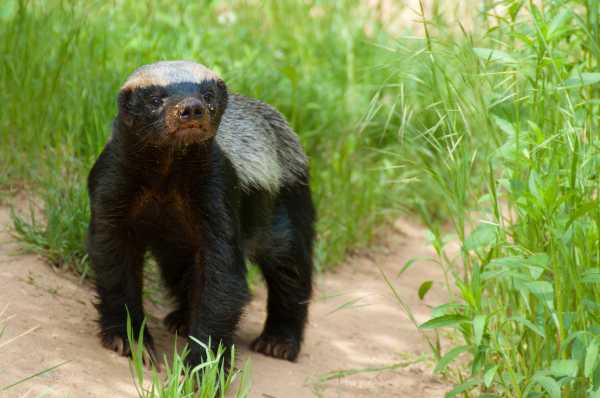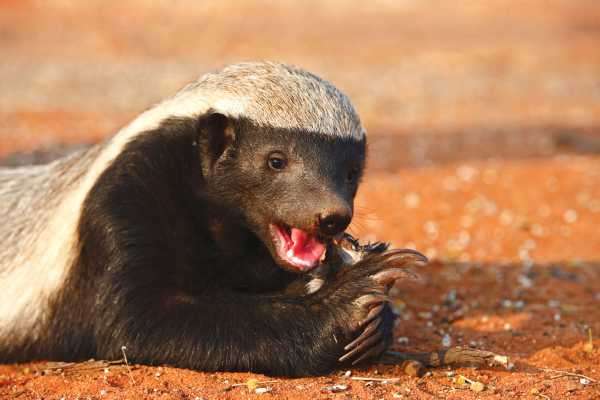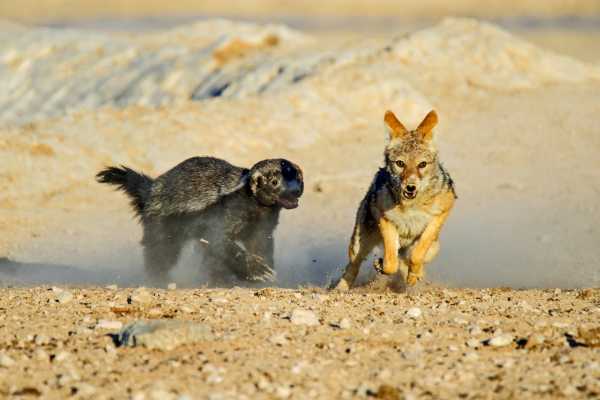
Honey badgers are small, muscular mammals known for their ferocious nature.
Honey badgers have the well-earned reputation of being fierce, feisty little mammals. Also known as a ratel, the honey badger belongs to the Mustelidae family of mammals, which also includes weasels, otters, ferrets, wolverines and other badger species. However, the honey badger is classified in its own subfamily, mellivorinae, and is the only species in the genus Mellivora, according to the Encyclopedia Britannica.
What are honey badgers?
The honey badger (Mellivora capensis) is about as big as a small- to medium-size dog, weighing between 13 and 30 lbs. (6 and 14 kilograms) and reaching 9 to 11 inches (23 to 28 centimeters) tall at the shoulder, according to National Geographic.
But the honey badger is more powerful than its compact size suggests — these animals are built for battle, not speed. Honey badgers have powerful 1.5-inch-long (4 cm) claws and teeth that are strong enough to crack a tortoise shell, making these small mammals a formidable opponent.
The stocky creatures have a short, thick coat of fur that’s black on the face, legs and bottom half of the body, with a broad white stripe running from the top of the head down the back and tail. Underneath the fur is a layer of loose, thick skin around its muscular neck, which protects the animal during fights, and allows it to wriggle around and defend itself when in the grasp of hungry predators, according to Africa Geographic. Porcupine quills, bee stings and dog bites rarely penetrate the honey badgers’ thick-skinned neck, according to Ronald Nowak’s book “Walker’s Carnivores of the World” (The Johns Hopkins University Press, 2005).
Honey badgers have relatively big brains for their body size. They are one of the few non-primate species to use tools — widely considered a sign of intelligence in the animal kingdom. Captive honey badgers have been known to work together to unlock gates and use rocks, a rake, mud and sticks to escape from their enclosure, according to a documentary about the animals produced by the BBC.
The honey badger also has a secret weapon to defend itself. Hidden at the base of its tail are two anal glands that squirt out a foul-smelling liquid that can be detected 130 feet (40 meters) away, according to the South African National Biodiversity Institute. The animals generally expel the substance to mark their territory, but they will also release a “stink bomb” when threatened or frightened. Jonathan Kingdon, a zoologist at the University of Oxford, said in his book “East African Mammals” (The University of Chicago Press, 1977) that this liquid may have a calming effect on bees, allowing honey badgers to more safely raid beehives.

Honey badgers have long, strong claws and sharp teeth — perfect for ripping their apart. What do honey badgers eat?
Honey badgers are omnivores, feasting on a wide range of food, including birds, reptiles, rodents, berries, roots and fruits. Their keen sense of smell helps them sniff out food hidden underground, while their long, strong claws help them dig for or catch that food, then rip their meal into pieces. They aren’t picky eaters and will scavenge whatever they can; three honey badgers have been seen chasing seven adult lions away from their kill, according to the BBC documentary.
Honey badgers are ferocious hunters, known to take on powerful animals, such as the South African oryx, a large, horned antelope that’s more than 10 times the size of a honey badger. They’re also persistent hunters, willing to travel 20 miles (32 kilometers) in their pursuit of a meal, the BBC documentary reported.
Although honey badgers are named after their presumed fondness for honey, they’re actually interested in the bee larvae found in honey rather than the sugary syrup itself. The small mammals love bee larvae so much that they’ll tolerate hundreds of stings from angry bees to get their claws on the sweet stuff. But not all raids are successful — desperate honey badgers have been found stung to death in large beehives, according to National Geographic.
As fearless predators, honey badgers won’t hesitate to take down scorpions or venomous snakes for dinner. However, those meals fight back, and the honey badger may receive a mean bite or sting from its prey, such as the highly venomous Cape cobra (Naja nivea), whose venom can temporarily knock out a honey badger. But after a couple of hours, the honey badger wakes up and continues its meal (if the meal hasn’t already left).
Snakes, including venomous ones, are an “excellent source of meat” for honey badgers, making up to 25% of the animals’ diet, Danielle Drabeck, an evolutionary biologist at the University of Minnesota, told Slate Magazine. And in order to dine on venomous snakes, which would be an otherwise deadly meal option for most carnivores, honey badgers have evolved a special kind of immunity to the toxins in snake venom. In their 2015 study published in the journal Toxicon, Drabeck and her colleagues found that honey badgers have evolved a series of genetic mutations that prohibit snake venom toxin from binding to cellular receptors that would signal their nervous system to shut down. A similar venom-defense mechanism has evolved in other mammals that share habitat with venomous snakes, including mongooses, hedgehogs and even wild pigs.
Honey badgers have few natural predators, but they are occasionally hunted by leopards, lions and hyenas, Slate Magazine reported. However, the honey badger’s aggressive nature does not make them an easy meal, and given the honey badger’s small size, predators’ efforts are often better spent catching an easier meal with more meat.
Where do honey badgers live?
Honey badgers are native to sub-Saharan Africa, the Middle East and India. These incredibly tough and hardy creatures adapt well to a variety of habitats and can live just as well in a rainforest as they can in the mountains. Typically, honey badgers have large home ranges of about 193 square miles (500 square km), according to National Geographic.
Honey badgers are territorial creatures and will use their scent glands to mark their territory. Male honey badgers have larger territories than females, and their territories can overlap with female territories, according to the South African National Biodiversity Institute.
Honey badgers don’t typically settle in the same spot at the end of each night, but instead will make a new bed in a tree, rock crevice or hole dug into the ground. The creatures are expert diggers and can build a burrow in hard ground in just 10 minutes. But the honey badger will just as happily make itself at home in an abandoned aardvark or mongoose burrow. They sleep for most of the day, hopefully in a spot that’s safe from predators. Honey badgers are mostly nocturnal, but they may come out during the day depending on weather conditions and the presence of predators, according to Africa Geographic.

Honey badger’s seem to have no fear. This one is ready to attack a jackal. When do honey badgers breed?
Honey badgers breed all year round, with the female normally giving birth to one cub about seven to 10 weeks after mating. Honey badger cubs, or kits, are born with their eyes closed, hairless and with pink skin. It takes about a month for the cub to develop its gray skin, fur and the characteristic wide, white stripe down its back, according to San Diego Zoo. It takes about two months for the cubs’ eyes to open, according to the North African Big Carnivore Foundation.
Cubs reach their adult size by about 6 months old, but will stay with their mother for up to two years, according to San Diego Zoo. During that time, the cub learns to master the art of digging, hunting and climbing trees — skills they need before they can venture out on their own.
Honey badgers can live for up to 26 years in captivity, according to the San Diego Zoo, and up to seven years in the wild, according to National Geographic.
The future of the honey badger
The International Union for Conservation of Nature’s Red List classifies honey badgers as a species of least concern, meaning their populations are stable in the majority of their native habitats. Some populations, however, are decreasing to the point where there are so few honey badgers left that they are considered endangered in that area. In some places, such as Morocco, Israel and Kazakhstan, they are a legally protected species in an effort to prevent their population from declining, according to the IUCN.
Though honey badgers can take down venomous snakes and confront lions, they are no match for humans. Honey badgers are hunted for bushmeat in certain areas, including Zambia and Guinea, and for use in traditional medicines as some believe that the creature’s reputation as being fearless and tenacious will somehow transfer to people, according to the IUCN Red List.
As humans develop once-wild areas and intrude on the honey badgers’ territory, instances of conflict between humans and honey badgers have increased. In particular, honey badgers are known for killing livestock and destroying beehives, which leads beekeepers and farmers to kill the honey badgers in order to protect human livelihoods. Some beekeepers and livestock farmers intentionally poison the honey badgers in retaliation for the loss of livestock or beehives, pushing honey badgers to extinction in some areas, according to the IUCN Red List.
And as scavengers, honey badgers are also often killed by poisoning and trapping programs meant for other pests, such as black-backed jackals and caracals. Since 2002, conservation initiatives have led to the production of “badger-friendly” honey, which is honey that comes from beekeepers who use non-lethal methods to protect their beehives. For example, the Endangered Wildlife Trust recommends that beekeepers place beehives on stands or trestles 3 feet (1 m) above the ground and away from things honey badgers can climb. Because honey badgers can’t jump, or reach that high, this is an effective method that helps prevent honey badgers from destroying beehives, saving both bees and honey badgers, and protecting the beekeepers’ livelihoods.
Additional resources:
Sourse: www.livescience.com





